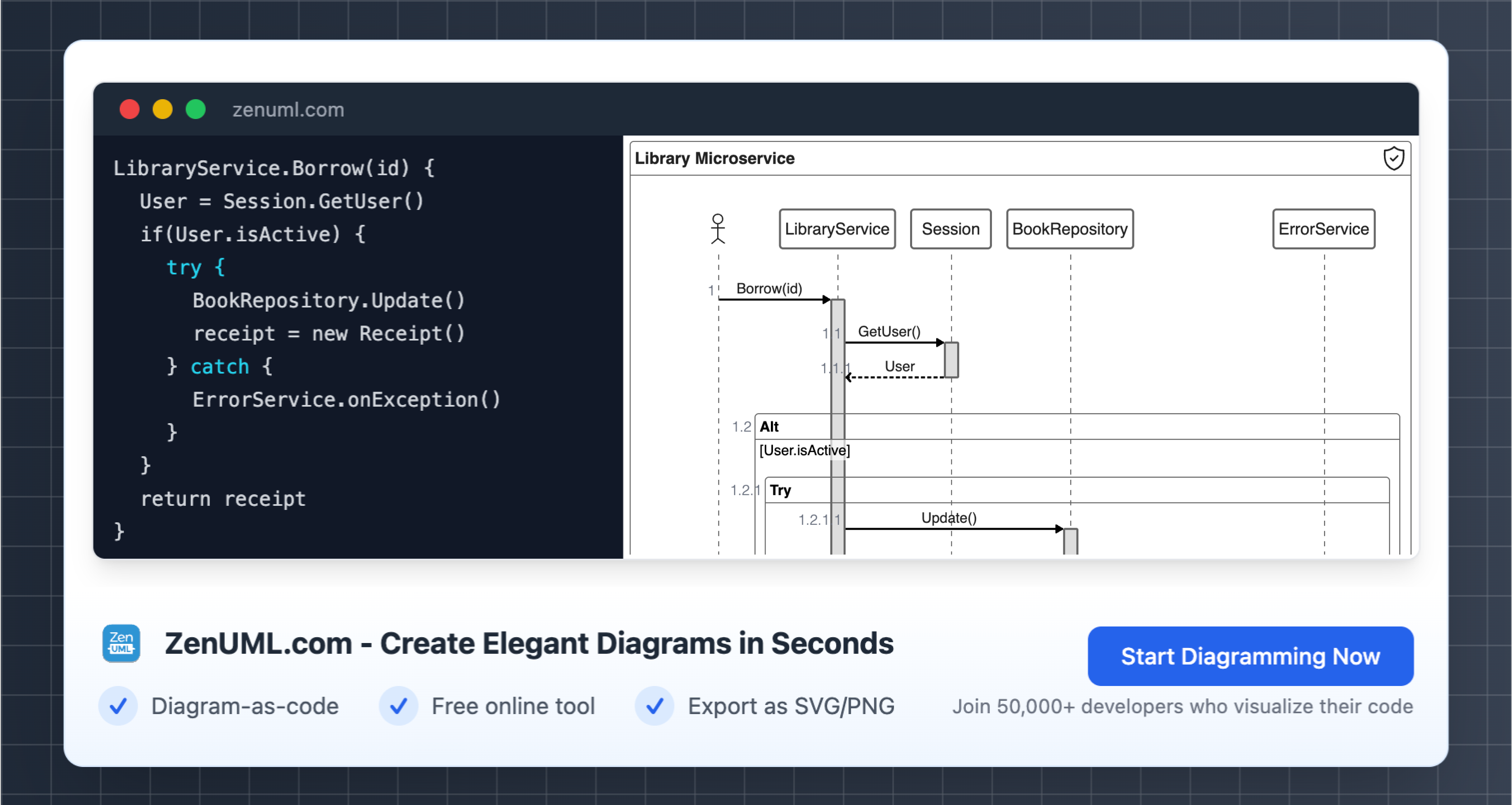Try ZenUML now!
Introduction
Understanding Business Process Modeling
Business process modeling (BPM) is an analytical approach that helps organizations to visualize their processes in a structured way. By creating a detailed map of business activities, companies can gain insights into the workflow and identify areas for improvement. BPM is crucial for achieving efficiency, clarity, and continuous development within a company's operations.
Introduction to Sequence Diagrams
Among the various tools and techniques used in BPM, sequence diagrams are particularly powerful. A sequence diagram is a type of interaction diagram that shows how processes operate with one another and in what order. It is a construct of UML (Unified Modeling Language) used for modeling the dynamics within various systems.
Importance of Sequence Diagrams in Business Process Modeling
Sequence diagrams are vital for they provide a clear understanding of how business transactions are carried out, which in turn aids in optimizing the processes. They offer a step-by-step representation of a scenario in the system, making it easier to see how each individual component interacts with others.
The Basics of Sequence Diagrams
What is a Sequence Diagram?
A sequence diagram visualizes the sequence of messages and interactions between parts of a system in a time-ordered flow. It is an essential tool for software developers, systems engineers, and business analysts when they are designing or analyzing systems.
Components of a Sequence Diagram
A typical sequence diagram includes objects, represented by rectangles at the top, and lifelines, depicted as dashed vertical lines. The messages exchanged between objects are represented by horizontal arrows, and the time progresses down the page.
Reading and Interpreting Sequence Diagrams
Understanding sequence diagrams involves recognizing how messages and events correlate over time. The start and end of a process, the actors involved, and the order of operations are all clearly displayed, which is invaluable for complex system analyses.
Sequence Diagrams in Action: Real-World Applications
Case Studies of Sequence Diagrams in Business Modeling
Various case studies demonstrate the effectiveness of sequence diagrams in different sectors. From healthcare to finance, sequence diagrams have been used to clarify complex transactions and optimize workflows.
How Sequence Diagrams Facilitate Communication and Planning
Sequence diagrams excel at bridging gaps between technical and non-technical stakeholders. They provide a universal language that assists in communication and strategic planning, ensuring all parties are on the same page.
Benefits of Using Sequence Diagrams in Different Industries
The benefits of sequence diagrams are not limited to one industry. They are versatile tools that can be applied to improve any business process by providing clarity and a deeper understanding of system interactions.
Creating Your Own Sequence Diagrams
Tools and Software for Sequence Diagram Creation
There is a variety of tools available for creating sequence diagrams, ranging from simple drawing tools to sophisticated software like Microsoft Visio, Lucidchart, and online UML tools. Each comes with its own set of features, catering to different needs and levels of complexity.
Step-by-Step Guide to Drawing a Sequence Diagram
Creating a sequence diagram involves understanding the process you wish to model, identifying the entities involved, and mapping out the interactions over time. Start with the initiation of the process and map out each subsequent action until the process concludes.
Tips and Best Practices for Effective Diagrams
To ensure effectiveness, sequence diagrams should be kept simple and clear. Avoid overcomplication, focus on the main interactions, and always keep the audience in mind. Regular reviews and updates to the diagrams are also essential as processes evolve.
Integrating Sequence Diagrams into Business Process Improvement
Identifying Bottlenecks with Sequence Diagrams
Sequence diagrams can help pinpoint bottlenecks in a system. By laying out the steps and interactions, it becomes easier to see where delays or issues arise, leading to more targeted improvements.
Enhancing Collaboration and Understanding Among Teams
By providing a clear visualization of processes, sequence diagrams enhance collaboration and understanding among teams. They serve as a reference point that can be easily understood by all team members, regardless of their technical background.
Continuous Improvement and Iteration with Sequence Diagrams
Business processes are not static, and sequence diagrams can accommodate this need for continuous improvement. They allow for the easy iteration of processes, helping businesses to stay agile and adapt to change effectively.
Conclusion
Recap of Sequence Diagram Benefits in Business Modeling
Sequence diagrams are invaluable tools in BPM. They offer a clear, visual representation of how business processes unfold and interact, which is essential for analysis and optimization.
Encouragement to Adopt Sequence Diagrams in Business Processes
Businesses are encouraged to adopt sequence diagrams to enhance their process modeling practices. The clarity and efficiency they bring can lead to significant improvements in how businesses operate.
Final Thoughts on the Future of Sequence Diagrams in Business Modeling
As businesses continue to evolve and seek out efficient ways to represent and improve their processes, sequence diagrams will undoubtedly play a pivotal role. Their ability to clearly convey complex interactions makes them an indispensable tool for the future of business process modeling.
Find our more on The Ultimate Guide to Business Process Modeling
Zenuml detailed feature roadmap available here.

